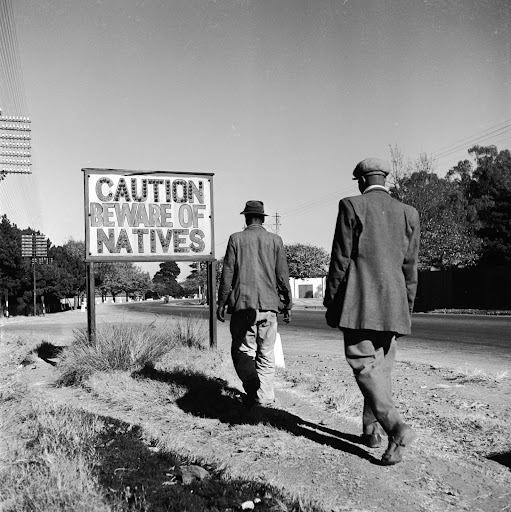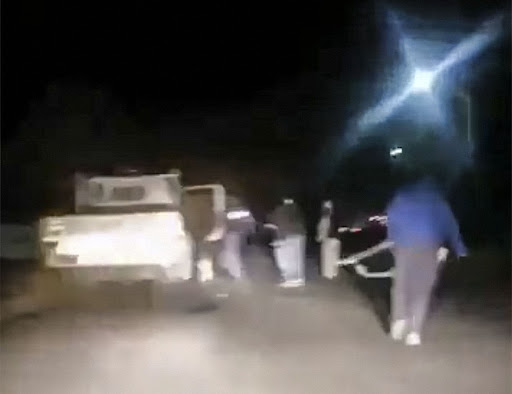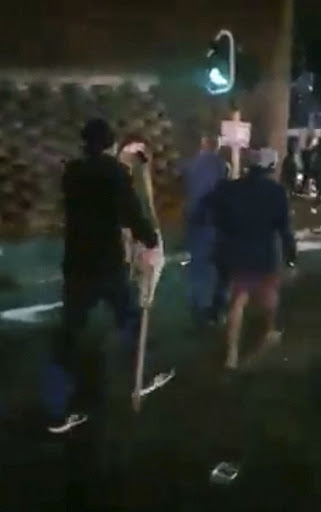The shadow of a lynching set against a crowd of people; the image was created and distributed by the NAACP, c. 1930s. The writer argues that recent, vigilante-led killings in South Africa echo the practice. (Everett Historical)
If photographs are ritual substances that are conduits for a return, a repetition, a nonforgetting, a haunting, what then, is the role of the camera in a communal setting of public humiliations, torture and, at worst, the public deaths that sprung out of last week’s mayhem?
In this racially fraught context, the camera becomes a picture-making time machine that captures racist fantasies pressed upon the flesh. Yet, on the other hand, the camera records the proof of the deed, and rightly so, for the promise of justice.
In images and videos that have popped up under the hashtag #PhoenixMassacre, Black people were whipped, shot, stoned and their cars burned by armed crowds in Phoenix and other areas.
In her essay Torture and the Ethics of Photography, which examines the Abu Ghraib torture photographs, Judith Butler reckons with this urgent question, asking us: “Is the taking of the photo a way of participating in the event it depicts? If so, in what way? Perhaps the camera promises a festive cruelty: ‘Oh good, the camera is here, let us begin the torture so that the photograph might capture and commemorate our act.’ If so, the photograph is already at work prompting, framing and orchestrating the act, the photograph captures the moment at its accomplishment. The photograph is a kind of promise that the event will continue. Does the photograph continue the act in the present?”
The pro-Jacob Zuma protests began with a political motive, but in a quick chain of events, they spiralled into what some have described as mass looting sprees, or as food riots for those who prefer to speak alongside the interests of the poor and hungry majority. More notably, these offshoots have been characterised in carelessly blanketing terms such as “criminal acts of looting”, because, in some aspects, they have been accompanied by arson and the destruction of properties in KwaZulu-Natal and Gauteng.
 Two Black men pass a road sign reading “Caution: Beware of Natives” in South Africa in 1956. (Getty Images)
Two Black men pass a road sign reading “Caution: Beware of Natives” in South Africa in 1956. (Getty Images)
What I discuss here is the visual manner in which some vigilante groups in the predominantly Indian and White residential areas between Pietermaritzburg and Durban have come into formation. These groups were assembled and glued together by old, anti-Black spatial apartheid designs, which made way for the igniting of extra-legal, racially violent flashpoints.
Warrior-like men appeared, circling barricades and armed with live ammunition, emboldened by what they declared as the righteous desire to defend and protect “their women and children”, their personal property and the remaining unlooted malls. These armed, commando-like men were prepared to face off with what was framed as a threatening “outside” force, seen as an encroachment of “the looters”.
The racial profiling aspects of these vigilantes are proclaimed in the media as an unwelcome invasion of the past, or as a history that we thought was buried and behind us. And so when the raw footage and the photographs flashed on our screens, it was experienced as akin to travelling back in time and witnessing, once again, some of the harrowing instances of racially-violent outbursts — in Soweto 1976, in Sharpeville 1960 and Marikana 2012.
What these sentiments expose is the collective assumption that racial violence is an odd dynamic out of place and out of time in present-day South Africa. Yet here we are, shadow-boxing with a racist spectre that keeps dexterously reinventing itself into the future.
It is argued in Ivan Evans’s Cultures of Violence: Racial Violence and the Origins of Segregation in South Africa and the American South that South Africa does not have a history of racial public lynching that is characteristic of the American-style ensemble. That would typically be composed of a lynch rope, bullets, fire and a lifeless and charred Black body hanging from a tree, like “strange fruit”, dangling amid a festive mob of spectators.
But South Africa does have a history of massacres. In their differences of style, form and scale, the visuality of South African massacres are composed of mutilated and dead Black people scattered on the ground in the aftermath of a mass shooting by armed officials. What is hardly acknowledged is how these images also play their part in labouring aside the orchestration of terror and the racial violence that occurs in, and perhaps arguably for, public view. Both lynchings and massacres, whether in the US or in the South African context, are nakedly public and they undeniably exude the aura of racial brutality. It must be mentioned that when township vigilante groups under apartheid practised necklacing as a method of resisting the intrusion of White infiltration, their victims were by and large Black people. It was members of their own communities that were necklaced and burned alive, in public view.
 A screengrab of a video showing a man being pulled out of a truck in KwaZulu-Natal as vigilantes “took control” of residential areas, actions that sometimes resulted in extra-legal killings. (Source: Twitter)
A screengrab of a video showing a man being pulled out of a truck in KwaZulu-Natal as vigilantes “took control” of residential areas, actions that sometimes resulted in extra-legal killings. (Source: Twitter)
More generally, in South Africa, the practice of abusing the poor is emerging publicly. We see it in brazen acts of “doing whatever you want” with the flesh of the propertyless, Black women and children and the LGBTQI community. It is a communal affair. In one vigilante video event, we even saw Black policemen, clad in full uniform, rounded up and instructed to sit down against the wall. Evans states that these vigilante movements are distinguished by their punishment of particular individuals who can be used as symbolic “stand-ins” for the community that they are seen to represent. “They emerge as a lack of faith in the adequacy of legal and institutional controls” over what, in this case, can be broadly described as poor Black people and others who look like them, people who remain abjectly excluded from the formal economy and institutional public life.
As the body count quietly continues, it still remains to be seen whether the Phoenix killings will officially be recognised as a massacre. But this doesn’t stop us from engaging the visual remains that exist among us right now in the form of the #PhoenixMassacre hashtag.
This litany of photographs and videos, some fake and some real, has comfortably entered into the symbolic ranks of communal violence.Across time and space, these racist images digitally flirt back with the horror scenes described in Abel Meeropol’s Strange Fruit; lynching scenes, which the camera recorded in its own realist visual terms. More pressingly, as viewers, these pictures lock us into a double bind, especially when we consider the default systemic denialism that is often relied on as a response to accounts of racial brutality. Police Minister Bheki Cele has backtracked from his initial statements that the Phoenix killings were about criminality first and not about race.
 In some of these vigilante scenes, police were punished as symbolic stand-ins of “outside elements” that they are seen to represent. (Source: Twitter)
In some of these vigilante scenes, police were punished as symbolic stand-ins of “outside elements” that they are seen to represent. (Source: Twitter)
These violent spectacles, on one hand, operate as proof of violation in a denialist society that is addicted to redemptive narratives of racial progress at all costs. It is harder to reckon with the fact that these images also circulate as a source of pleasure, which is fed by sadistic racial fantasies that now travel on Twitter and WhatsApp groups. As Mohammed Jameel Abdullah describes in his essay South Africa’s Gaping Wound (published on Africa is a Country): “These videos are shared and watched repeatedly across social media, racially charged viewers salivate with a carnal sense of pleasure as one racial group watches the other suffer and bleed.”
Indeed, they comment on whose body and personhood can be violated and communally looted without fear of a consequence. Their circulation builds up a collective tolerance that desensitises us, while reminding us of what we already know about the lowered value of Black life.
In the symbolic space of the video and photograph, these racist rituals also occupy multiple temporal zones at once. They are in the past, the present and the future. Time is suspended and rendered meaningless as we go through the gauntlet of anti-Black fantasies, again and again. The act of recording violation can furtively invite and promise sadistic fantasies for succeeding generations to flirt with and embrace in the future. This is why it is necessary that, even in the heat of the moment, acts of violence are physically stopped and condemned first, before they are given a second life in the symbolic realm.